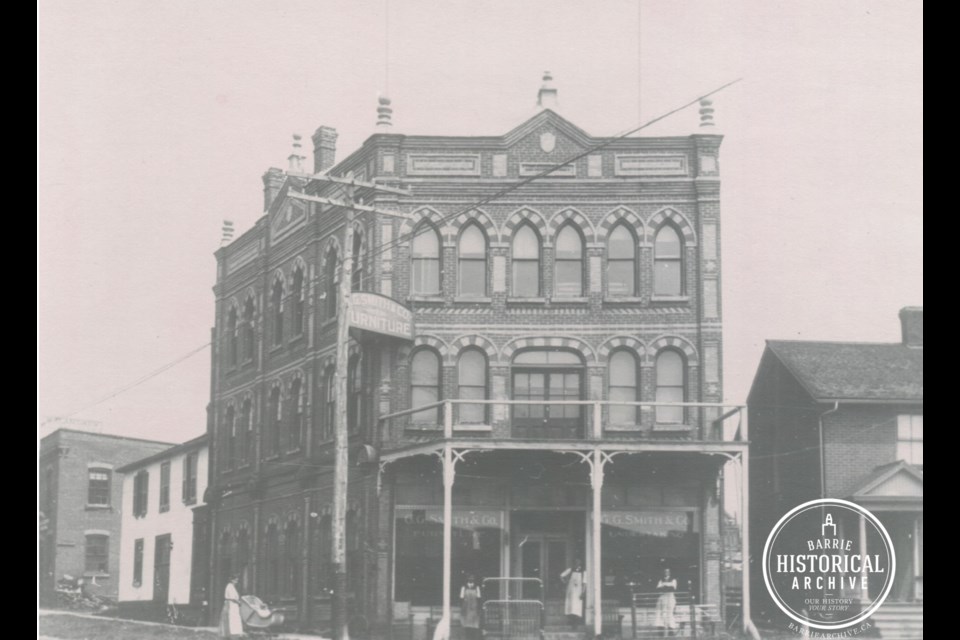This ongoing series from Barrie Historical Archive curator Deb Exel shows old photos from the collection and one from the present day.
G.G. Smith Furniture and Undertaking (2 Collier St.)
The odd and awkward corner at Bayfield and Collier streets in dowtown Barrie has always been that way – a jog in the road if you are coming from Ross Street to get to Collier, a sharp turn off Collier to head north on Bayfield or a sometimes-free-for-all of traffic trying to navigate this strange intersection.
And these days, where a fascinating building once stood at this weirdly angled corner, there is just an empty lot.
In 1873, Barr and Henry Carriage Works made wooden parts for wagons and carriages at their store at this address. They also rented the blacksmith shop of James Loftus which was located just to the north of them on Bayfield Street until they built a new two-storey blacksmith shop in 1881.
About 1884, they built their impressive three-storey factory and showroom on their existing corner location, where they manufactured carriages, sleighs, wagons, hearses, wheelbarrows and other vehicles.
In their new building, there was an elevator which could lift a carriage from the basement to the second floor for painting and varnishing, to the top floor where the trim shop and storeroom were located, and back down to the main-floor sales room.
An extension located along the east side of this pie-shaped lot connected the third floor of the carriage works building to their blacksmith shop on Bayfield Street.
By the end of the 1800s, G.G. Smith and Company had moved its furniture and undertaking business to the former carriage works building at 2 Collier St., still a highly ornate structure as shown in 1906, with its two-toned brick detail, double doors opening to a second-storey balcony and an elaborate parapet roof with finials.
George Gibson Smith came to Barrie in 1862 and worked at the Ball Planing Mill before starting a business and partnership in 1869, Smith and Moore Cabinet Makers and Undertaker, located just north of Five Points on the west side of Bayfield Street.
By 1897, G.G. Smith was on his own and operating out of a store at number 12 Collier St. (changed to No. 8 by the 1930s). His cabinet shop, hearse house and storage shed were tucked between two brick homes; the one to the west was still standing until the 1970s.
According to early plans of the property, a wooden structure for undertaking was located at the rear of the L-shaped property, close to Clapperton Street.
G.G. Smith was a member many societies, including the Orange Lodge, one having been built in 1876, conveniently right around the corner from Smith’s Cabinetry on Collier Street and north of the undertaking building on Clapperton Street. Records indicate that the Salvation Army barracks used the main floor and the Orangemen met upstairs.
By 1887, G.G. was a Master in Corinthian Lodge No. 96 and held several positions within the groups he belonged to. Generally, G.G. was very active in the community as a school trustee, with the Collier Street Methodist Church, as founder of the popular Barrie Citizen’s Band (a particular source of pride for him), and as a fire department volunteer for 45 years, 18 of them as chief.
The Simcoe County Archives also has a record of a contract between the Post Office Department of Canada and George Gibson Smith for Conveying Her Majesty’s Mails between Barrie and Midhurst, 1888. G.G. was clearly a busy man!
On a bitterly cold Christmas Eve 1914, after spending the previous two days gathering provisions, G.G. delivered these items to the poor until 11 p.m., so that they could have a better Christmas.
Two days later, on Dec. 26, after rushing in to direct his crew at a fire at the Queen’s Hotel, he collapsed and was taken by sleigh to his home at the corner of Collier and Clapperton streets where he passed away at the age of 74.
G.G. Smith was the oldest active fire chief in Ontario.
The Northern Advance reported that his funeral was among the largest ever seen; businesses closed for one hour and bells tolled for this much-admired public servant. The fire hall was draped in black and a fire reel, also draped in black, was included in the procession to the cemetery.
G.G. Smith left behind his wife and five adult children.
G.G.’s son, Charles, had taken over the family business two years before his father had passed.
The Smith family appears to have had three properties in this short block: the large operation at 2 Collier St., the original cabinet-making and undertaking shop a couple doors down, and G.G.’s gracious home at the other corner, where his son, Harry Austin Smith, was residing in the late 1930s (originally built by Christopher Harrison, it was also the home of noted Canadian historian Arthur Lower).
H.A. Smith was a well-known druggist with a shop at 6 Dunlop St. (later Tamblyn’s). Harry Austin Smith also had the foresight to assemble photographs and artifacts documenting Barrie from the late 1800s until the 1960s, which his grandchildren — Paul, Diane, Susan and David — generously donated to the Barrie Historical Archive so that generations to come may enjoy and learn from these remarkable mementos from the past. Many of the wonderful images featured each week in this column are from the Harry Austin Smith Collection.
In 1947, Samuel and Sybil Steele moved to Barrie from Newfoundland and opened a china and gift shop, Steele’s China, in the early 1950s at 2 Collier St. Their son, Harris, took over the business after graduating from Barrie Central Collegiate. Harris Steele, a well-known downtown businessman, was also part of the Barrie Bell restoration project.
Sadly, this incredibly historic building was demolished in 2009.



